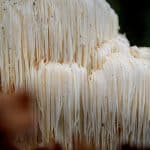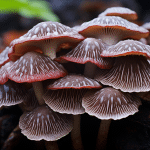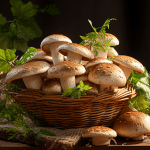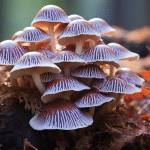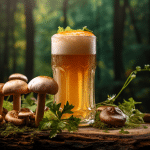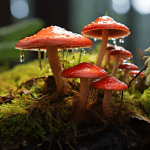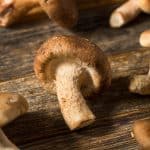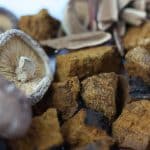Few mushrooms are more satisfying to watch grow than a blue oyster mushroom. It is highly forgiving and easy to grow, making it an ideal choice for beginners. The fruits grow quickly, sometimes double in size every day.
The mushroom starts off brightly blue, turning gray as it ripens. These mushrooms are perfect candidates for growing outdoors, since they require the most fresh air of all of the mushrooms we grew.
Blue Oyster Scientific Name: Pleurotus Ostreatus
What Are Blue Oyster Mushrooms
The oyster mushrooms in the Blue Oyster are grown in large groups, taking the characteristic shelves-like form of Pleurotus species. Size and shape can vary greatly depending on growing conditions. Blue oyster mushrooms require an extremely high degree of exchange of cool air, higher than any mushroom that is normally grown. Grown in high CO2 environments, a blue oyster mushroom will have long, dense stalks, topped by tiny caps.
They also have an enormous amount of spores, and will fill your growing space with thick, sticky loads of them very quickly. The clusters of mushrooms begin with deep blue colors, and will eventually become gray in color as they grow older.
The fruits are typically dense and meaty, making them highly versatile for cooking.
Blue Oyster Mushrooms Natural Habitat
Found in hardwood Log Trees and Spruces, Live, Die, and Decay. Found during spring and fall.
How Hard is it to Grow Blue Oyster Mushrooms
Agar
Blue oyster mushrooms grow very well in agar. They appear to prefer Agar with yeasted malt. Growth may be rhizomorphic, eventually becoming thick and puffy. Blue oyster mushroom mycelium has a tendency to produce brown/orange metabolites, often misidentified as contaminant, though this may be a sign of mycelium fighting contaminant.
Best Spawn for Blue Oyster Mushrooms
Rye grains are the best, but Sawdust Spawns work well too. Some have reported higher straw yields when sawdust spawn is used instead of wheat spawn. Oyster spawn has a distinctive smell similar to mushrooms.
Easy to crack with shaking to create no-fuss spawn on a large substrate. Blue oyster spawns tend to get steamed, producing pockets of water inside of your spawn bag or spawning container. Try positioning your spawns to prevent the grains from sitting in the water as they colonize.
Substrate for Blue Oyster Mushrooms
Pasteurized straw logs are highly effective with blue oyster mushrooms. Use high rates of sprouting to get better harvests. Straw bales will yield more flushes as long as you keep the contaminants in check. Supplementing with blocks of sawdust works pretty well too, but it is more economical for straw to generate similar results. Blue oyster mushrooms will devour just about anything, even growing on coffee grounds, garbage paper, sugarcane, grass, and a host of other waste industrial products.
Fruiting Containers for Blue Oyster Mushrooms
Use poly tubing to wrap the straw bales, 16 lay flat diameter. Too thin of straw logs can result in anaerobic middles in logs, which eventually becomes contaminated. Growing bags work by cutting holes into the sides of the bag to let mushrooms grow through, or just cutting the top of the bag and letting fruit grow at the top of the log. Blue oyster mushrooms are incredibly versatile, and can be grown even in 5-gallon buckets with holes punched into them, or any container you can think of.
Expected Yield When Growing Blue Oyster Mushrooms
Blue oyster mushrooms have the potential for exceedingly high yields, with a bio-efficiency of as much as 200%. Selecting older mushrooms will increase yields, but you run the risk of covering your growing space in spores, or harvesting mushrooms past their culinary prime.
Harvesting Blue Oyster Mushrooms
Harvest a mushrooms by picking it off, or cutting out whole clusters. Mushrooms will keep longer when handled gently and stored in a cluster rather than picking out individual mushrooms. Blue oyster mushrooms will keep in the refrigerator longer than pink or yellow ones. Blue oysters tend to keep growing in the refrigerator, and the mycelium starts growing off of the stalks.
Blue Oyster mushrooms can also be dried in a dehydrator for longer-term storage. Blue Oysters have an enormous amount of spores, the most of any mushroom. They also have the largest requirements for fresh air of all other edible mushrooms, making growing the big fruits in an indoor environment quite challenging.
They keep in the refrigerator a long time, but can begin to sprout mycelium off of their stalks. The stems may get a little chewy.
Cooking Blue Oyster Mushrooms
Blue oyster mushrooms are used in many dishes, particularly soups and pastas. The taste is unique and it is very tasty. The stalks can be chewy, so you might want to avoid using them for the stalks in most dishes. Dried mushrooms can be rehydrated in water, or placed straight into soups and stews.
Things to Keep in Mind When Growing Blue Oyster Mushrooms
Incubate at room temperature for 14-21 days. Watch for pools of water or “sweat” on spawn. Drop temperature to 15degC. Increase humidity to 95%.
Should begin pinning within less than 7 days. Temperatures of 15-20oC. Fast growing, Should have fruit ready for picking 5 days or less after pin.
Blue oyster mushrooms are an interesting mushroom to grow at home. It grows quickly and is satisfying to look at. The blue color at first is striking, leading to big, tasty fruits.
The mushroom is also an excellent choice to grow outdoors, producing far larger fruits with comparatively less upkeep. The mushroom will also keep for a relatively long time in a refrigerator, and it can be dehydrated for longer-term storage.
Try growing your own Blue Oyster Mushrooms today! Good luck on your growing endeavors.







